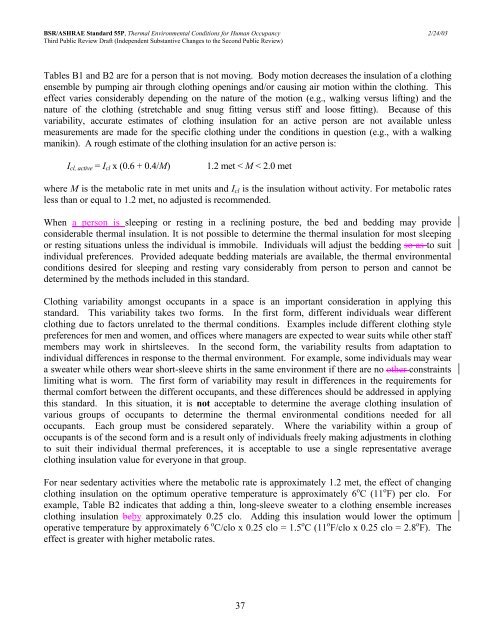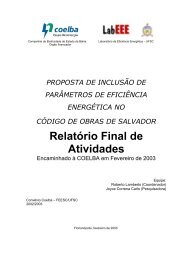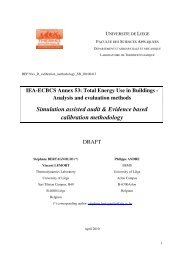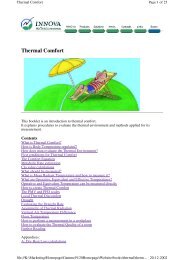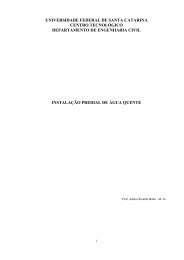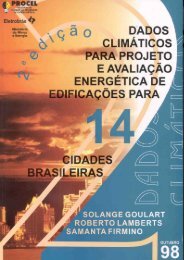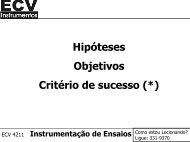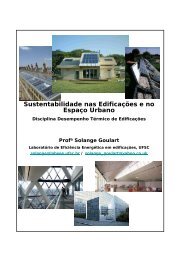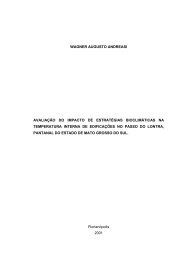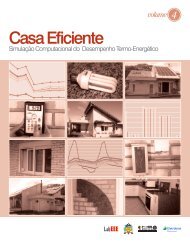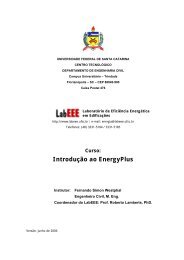ASHRAE STANDARD - 55R
ASHRAE STANDARD - 55R
ASHRAE STANDARD - 55R
Create successful ePaper yourself
Turn your PDF publications into a flip-book with our unique Google optimized e-Paper software.
BSR/<strong>ASHRAE</strong> Standard 55P, Thermal Environmental Conditions for Human Occupancy 2/24/03<br />
Third Public Review Draft (Independent Substantive Changes to the Second Public Review)<br />
Tables B1 and B2 are for a person that is not moving. Body motion decreases the insulation of a clothing<br />
ensemble by pumping air through clothing openings and/or causing air motion within the clothing. This<br />
effect varies considerably depending on the nature of the motion (e.g., walking versus lifting) and the<br />
nature of the clothing (stretchable and snug fitting versus stiff and loose fitting). Because of this<br />
variability, accurate estimates of clothing insulation for an active person are not available unless<br />
measurements are made for the specific clothing under the conditions in question (e.g., with a walking<br />
manikin). A rough estimate of the clothing insulation for an active person is:<br />
Icl, active = Icl x (0.6 + 0.4/M) 1.2 met < M < 2.0 met<br />
where M is the metabolic rate in met units and Icl is the insulation without activity. For metabolic rates<br />
less than or equal to 1.2 met, no adjusted is recommended.<br />
When a person is sleeping or resting in a reclining posture, the bed and bedding may provide<br />
considerable thermal insulation. It is not possible to determine the thermal insulation for most sleeping<br />
or resting situations unless the individual is immobile. Individuals will adjust the bedding so as to suit<br />
individual preferences. Provided adequate bedding materials are available, the thermal environmental<br />
conditions desired for sleeping and resting vary considerably from person to person and cannot be<br />
determined by the methods included in this standard.<br />
Clothing variability amongst occupants in a space is an important consideration in applying this<br />
standard. This variability takes two forms. In the first form, different individuals wear different<br />
clothing due to factors unrelated to the thermal conditions. Examples include different clothing style<br />
preferences for men and women, and offices where managers are expected to wear suits while other staff<br />
members may work in shirtsleeves. In the second form, the variability results from adaptation to<br />
individual differences in response to the thermal environment. For example, some individuals may wear<br />
a sweater while others wear short-sleeve shirts in the same environment if there are no other constraints<br />
limiting what is worn. The first form of variability may result in differences in the requirements for<br />
thermal comfort between the different occupants, and these differences should be addressed in applying<br />
this standard. In this situation, it is not acceptable to determine the average clothing insulation of<br />
various groups of occupants to determine the thermal environmental conditions needed for all<br />
occupants. Each group must be considered separately. Where the variability within a group of<br />
occupants is of the second form and is a result only of individuals freely making adjustments in clothing<br />
to suit their individual thermal preferences, it is acceptable to use a single representative average<br />
clothing insulation value for everyone in that group.<br />
For near sedentary activities where the metabolic rate is approximately 1.2 met, the effect of changing<br />
clothing insulation on the optimum operative temperature is approximately 6 o C (11 o F) per clo. For<br />
example, Table B2 indicates that adding a thin, long-sleeve sweater to a clothing ensemble increases<br />
clothing insulation beby approximately 0.25 clo. Adding this insulation would lower the optimum<br />
operative temperature by approximately 6 o C/clo x 0.25 clo = 1.5 o C (11 o F/clo x 0.25 clo = 2.8 o F). The<br />
effect is greater with higher metabolic rates.<br />
37


